Related Research Articles

A mango is an edible stone fruit produced by the tropical tree Mangifera indica. It is believed to have originated between northwestern Myanmar, Bangladesh, and northeastern India. M. indica has been cultivated in South and Southeast Asia since ancient times resulting in two types of modern mango cultivars: the "Indian type" and the "Southeast Asian type". Other species in the genus Mangifera also produce edible fruits that are also called "mangoes", the majority of which are found in the Malesian ecoregion.

A chutney is a spread typically associated with cuisines of the Indian subcontinent. Chutneys are made in a wide variety of forms, such as a tomato relish, a ground peanut garnish, yogurt or curd, cucumber, spicy coconut, spicy onion or mint dipping sauce.
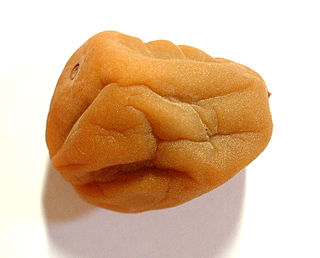
Umeboshi are pickled (brined) ume fruits common in Japan. The word umeboshi is often translated into English as 'salted Japanese plums', 'Japanese plums' or 'preserved plums'. Ume is a species of fruit-bearing tree in the genus Prunus, which is often called a "plum", but is actually more closely related to the apricot. Pickled ume which are not dried are called umezuke (梅漬け).

Sinigang is a Filipino soup or stew characterized by its sour and savory taste. It is most often associated with tamarind, although it can use other sour fruits and leaves as the souring agent. It is one of the more popular dishes in Filipino cuisine. The soup is usually accompanied by rice. In 2021, sinigang was rated as the world's best vegetable soup by TasteAtlas.

Tapa is dried or cured beef, pork, mutton, venison or horse meat, although other meat or even fish may be used. Filipinos prepare tapa by using thin slices of meat and curing these with salt and spices as a preservation method.

Shrimp paste or prawn sauce is a fermented condiment commonly used in Southeast Asian and Southern Chinese cuisines. It is primarily made from finely crushed shrimp or krill mixed with salt, and then fermented for several weeks. They are either sold in their wet form or are sun-dried and either cut into rectangular blocks or sold in bulk. It is an essential ingredient in many curries, sauces and sambal. Shrimp paste can be found in many meals in Cambodia, Indonesia, Laos, Malaysia, Myanmar, the Philippines, Singapore, Thailand, and Vietnam. It is often an ingredient in dip for fish or vegetables.

The generic term for condiments in the Filipino cuisine is sawsawan. Unlike sauces in other Southeast Asian regions, most sawsawan are not prepared beforehand, but are assembled on the table according to the preferences of the diner.

Siopao, is a Philippine steamed bun with various fillings. It is the indigenized version of the Fujianese baozi, introduced to the Philippines by Hokkien immigrants during the Spanish colonial period. It is a popular snack in the Philippines and is commonly sold by bakeries and restaurants.

Crack seed is a category of snacks that originated in China. It is highly popular in many regions, such as Hawaii. Crack seed are preserved fruits that have been cracked or split with the seed or kernel partially exposed as a flavor enhancement. This type of snack is commonly referred to in the Cantonese language as see mui ; it arrived in Hawaii during the 19th century, when Cantonese immigrants were brought to work on the plantations. The larger numbers of Japanese who later came to work on the plantations adopted the snack, being similar to the Japanese umeboshi.

Atchara is a pickle made from grated unripe papaya originating from the Philippines. This dish is often served as a side dish for fried or grilled foods such as pork barbecue.
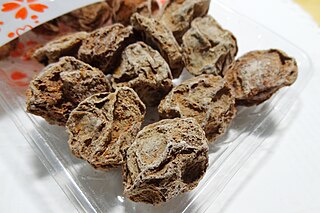
Li hing mui, known as huamei in Mainland China, is salty dried Chinese plum. It has a strong, distinctive flavor and is often said to be an acquired taste, as it has a combination of sweet, sour, and salty taste. Originally from Guangdong Province, the name "li hing mui" means "traveling plum". "Li hing" is "traveling" and "mui" is "plum" in Cantonese. Li hung mui is called hoshiume in Japan, where the salty and sour umeboshi is also popular.
Saladitos are plums or apricots, which are dried, salted and which can also be sweetened with sugar and anise or coated in chili and lime. A common misconception is that saladitos and chamoy are the same thing; saladitos are the dried salted fruit, whereas chamoy is made from the leftover brine.
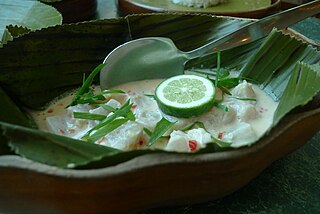
Kinilaw is a raw seafood dish and preparation method native to the Philippines. It is also referred to as Philippine ceviche due to its similarity to the Latin American dish ceviche. It is more accurately a cooking process that relies on vinegar and acidic fruit juices to denature the ingredients, rather than a dish, as it can also be used to prepare meat and vegetables. Kinilaw dishes are usually eaten as appetizers before a meal, or as finger food with alcoholic drinks. Kinilaw is also sometimes called kilawin, but it should not be confused with the northern Philippine grilled meat dish, kilawin, to which it is related to but is different.

Chamoy is a variety of savory sauces and condiments in Mexican cuisine made from pickled fruit. Chamoy may range from a liquid to a paste consistency, and typically its flavor is salty, sweet, sour, and spiced with chilis.
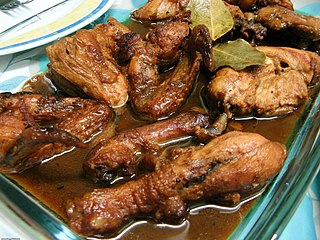
Philippine adobo is a popular Filipino dish and cooking process in Philippine cuisine that involves meat, seafood, or vegetables marinated in vinegar, soy sauce, garlic, bay leaves, and black peppercorns, which is browned in oil, and simmered in the marinade. It has occasionally been considered the unofficial national dish in the Philippines.
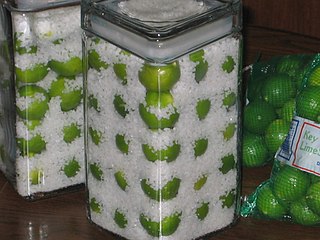
Pickled fruit refers to fruit that has been pickled. Pickling is the process of food preservation by either anaerobic fermentation in brine or immersion in vinegar. Many types of fruit are pickled. Some examples include peaches, apples, crab apple, pears, plums, grapes, currant, tomato and olives. Vinegar may also be prepared from fruit, such as apple cider vinegar.

UFC is a brand of banana ketchup owned by Nutri-Asia, Inc. The brand was first introduced in the Philippines in 1969 by Universal Foods Corporation.
References
- ↑ "Kiamoy". Tagalog Lang. Retrieved November 2, 2021.
- ↑ "Vida's Champoy (Prunes in Balsamic Vinegar)". Lulu Cooks and Tells. May 3, 2016. Retrieved November 2, 2021.
- 1 2 Polistico, Edgie (2017). Philippine Food, Cooking, & Dining Dictionary. Anvil Publishing, Inc. ISBN 9786214200870.
- 1 2 "Kiamoy: What Exactly Is Kiamoy? (A Filipino Street Food)". Philippine News. March 28, 2020. Retrieved November 2, 2021.
- 1 2 3 "Tsampoy". Tagalog Lang. Retrieved November 1, 2021.
- ↑ "Mano Po". Drink Manila. December 21, 2016. Retrieved November 2, 2021.
- ↑ Lim, Francis. "Crispy Kiamoy Chicken Wings Recipe". Yummy.ph. Retrieved November 2, 2021.
- ↑ "Plum Powder". Market Manila. September 11, 2005. Retrieved November 2, 2021.
- ↑ Tellez, Lesley (May 29, 2019). "The Spicy, Sour, Ruby-Red Appeal of Chamoy". Taste. Retrieved November 1, 2021.
- ↑ "Chamoy". Masa Americana. June 17, 2021. Retrieved November 1, 2021.
